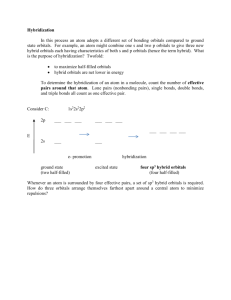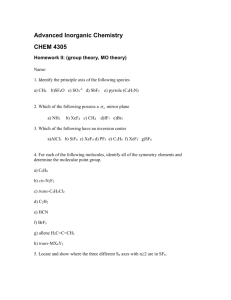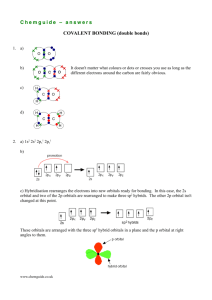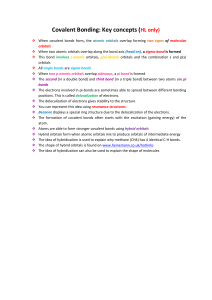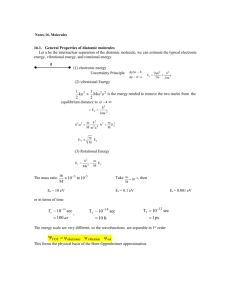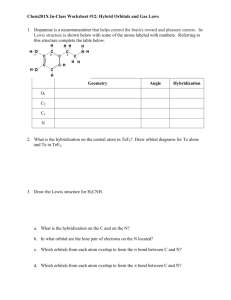14.2 Hybridization revised
advertisement
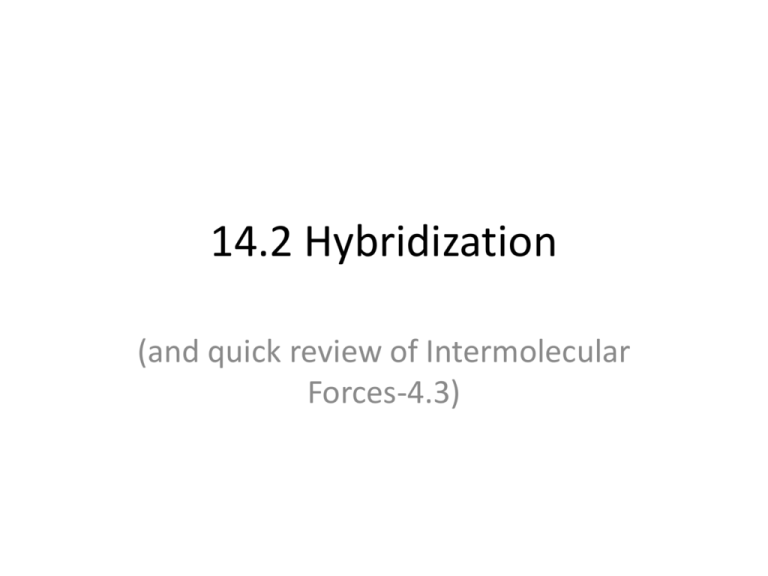
14.2 Hybridization (and quick review of Intermolecular Forces-4.3) Chemical Bonds Intramolecular Forces • Bonds within Molecules – Ionic – Covalent – Metallic Intermolecular Forces • Bonds between Molecules – van der Waals Forces • London Forces • Dispersion Forces – Dipole-Dipole Forces – Hydrogen Bonds © 2009, Prentice-Hall, Inc. Comparing Strengths • Which are stronger-intermolecular forces or intramolecular forces? • What types of bonds are being broken when melting an ionic compound? Covalent Compound? van der Waal’s Forces aka London Dispersion Forces • Weakest intermolecular force • Exist between all molecules • A temporary dipole in one nonpolar molecule induces a dipole in neighboring molecules—resulting in an instantaneous attraction between the molecules. © 2009, Prentice-Hall, Inc. van der Waal’s Forces aka London Dispersion Forces • Weakest intermolecular force • Exist between all molecules • A temporary dipole in one nonpolar molecule induces a dipole in neighboring molecules—resulting in an instantaneous attraction between the molecules. © 2009, Prentice-Hall, Inc. Dipole-Dipole Forces • Polar molecules are attracted to each other – Electrostatic attractions – The positive end of one is attracted to the negative end of the other and viceversa. © 2009, Prentice-Hall, Inc. Dipole-Dipole Forces • The more polar the molecule, the higher its boiling point. © 2009, Prentice-Hall, Inc. Hydrogen Bonding • Interaction experienced when H is bonded to highly electronegative and small atoms like N, O, or F . • Molecules are extremely polar • Form unusually strong dipole-dipole interaction © 2009, Prentice-Hall, Inc. Hydrogen Bonding • Considerably stronger than vDW or dipole-dipole forces. • Molecules that are hydrogen bonded have higher boiling and melting points. • Hydrogen bonded molecules have greater solubility in water. © 2009, Prentice-Hall, Inc. Warm-up 10/25 1. Determine the molecular shape of: CH3CHCHCN Now to 14.2-Hybridization • Orbital Shapes Sigma and Pi Bonds – Sigma (σ) Bonds End-to-end overlap – Pi bonds (π) Bonds Sideways overlap Single, Double, and Triple Bonds Explaining the bond strengths/lengths • Single bond is longest/weakest – Least area of overlap (just sigma) • Double bond shorter/stronger – 3 areas of overlap (one sigma and one pi) – Pulls two nuclei closer together • Triple bond shortest/strongest – 5 areas of overlap (1 sigma, 2 pi) – Two nuclei even closer together Hybridization • http://liakatas.org/chemblog/?page_id=17#Si mulations • CH4 - 1s2 2s2 2p2 – How can we explain the 4 equivalent bonds? – Bonding electrons are in different orbitals • 2 in the 2p orbitals and 2 in the 2s orbital Hybrid orbitals are created • Must be 4 equivalent orbitals – The s and p orbitals involved in forming sigma bonds (or containing lone pairs), mesh together – Form equal number of highly directional hybrid orbitals • CH4 = four sp3 hybrid orbitals CH4 • 4 sp3 orbitals – sp3 orbitals look like half p orbitals Key Ideas • When atoms join to form molecules (except H) – Outer atomic orbitals produce hybrid orbitals • Focus only on the central atom • Results in same number of hybrid orbitals as original orbitals involved – Now they all have the same energy and are arranged symmetrically sp3 hybridization in water In the case of water, the three 2p orbitals of the oxygen atom are combined with the 2s orbital to form four sp3 hybrid orbitals. The two non-bonded electron pairs will occupy hybrid orbitals. Again we need a hybrid orbital for each atom and each pair of nonbonding electrons. Water has two hydrogen atoms and two nonbonded pairs of electrons when we draw the electron-dot formula. sp2 hybridization in Boron Trifluoride In the boron trifluoride molecule, only three groups are arranged around the central boron atom. In this case, the 2s orbital is combined with only two of the 2p orbitals (since we only need three hybrid orbitals for the three groups...thinking of groups as atoms and non-bonding pairs) forming three hybrid orbitals called sp2 hybrid orbitals. The other porbital remains unhybridized and is at right angles to the trigonal planar arrangement of the hybrid orbitals. The trigonal planar arrangement has bond angles of 120o. sp Hybridization • BeCl2 Shapes to Hybrid Orbitals Lewis Dot Structures to Hybrid Orbitals • From Lewis Dot Structure: – Number of orbitals around central atom = number of charge centers • Only care about sigma bonds so single, double and triple bonds counted as one. Example: H2O -2 sigma bonds and 2 non-bonding pairs 4 orbitals so sp3 hybridization Homework Alternative text Ch. 4 • Pg. 117 – #1, 2 • Pg. 118 – #1, 2


